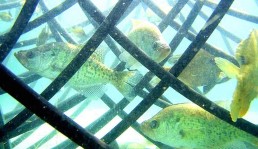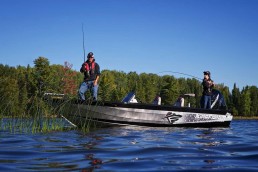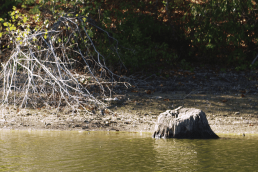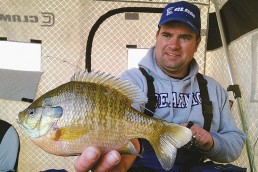Most Fish Love Cover…so Find it or Make It
SHARE THIS POST
Well-informed anglers know that most fish, like bass, bluegills, crappies, and walleyes, are creatures of cover. Whether it is rocks, wood or weeds, cover is essential to the food chain because it provides nutrients for the prey and an ambush point for predator fish.
Fertile, natural lakes in Florida, Minnesota and Wisconsin have an abundance of weed cover. Their lakes support significant weed growth because of water clarity, nutrients and soft, silted bottom content.
A few man-made reservoirs have superb, and sometimes, too much weed growth. Three that have gained much attention over the years are Rodman Pool in Florida, Kentucky Lake in Tennessee and Kentucky and Lake Taneycomo near Branson, Mo.
Weeds provide a food chain that starts with oxygen and microorganisms, and then continues through the ultimate predators like northern pike, and muskie. Unfortunately, property owners and recreational boaters have a different view of weeds and their benefit to the aqua-system. They see them as a nuisance, clogging boat lanes, piers, and swimming areas.
Therein lays the rub. Anglers know fishing improves with an appropriate amount of weeds, and they object to the total annihilation of weeds with herbicides or by mechanized cutting. Highland reservoirs of the mid-south usually have sparse weed populations, avoiding that particular conflict of interest.
Some fish have little regard or need for cover to feed and survive. Sea bass species like white, hybrid, striped bass, and paddlefish are pelagic, feeding on open water shad and organisms. Carp will feed on certain weeds and algae while catfish typically prefer open, bottom areas to prey on crayfish and invertebrates.
Walleyes are comfortable in the weedy natural lakes of the North Country, rocky highland reservoirs of the mid-south, or major, slow moving rivers of the Midwest. Their forage consists of minnows, crayfish, invertebrates and shad.
Some northern natural lakes are too infertile to support weeds. For those lakes, state fisheries management departments often plant “fish cribs” made of logs and lashed together in the shape of a small cabin, 8 to 10 feet square, and 3 to 5 feet tall.
Are you enjoying this post?
You can be among the first to get the latest info on where to go, what to use and how to use it!
Constructed in the wintertime, then pulled onto the ice when it is very thick, they submerge the “cribs” in the springtime when the ice melts. People whose faith is strong in the tensile strength of ice handle that job.
Submerged standing timber in reservoirs not only provides cover for predator and prey, but it harbors the microorganisms that kick-start the food chain. In older reservoirs like Table Rock, Pomme de Terre, and Stockton, much of the soft wood timber has rotted away, leaving a few cedars. Cutting the timber at Lake of the Ozarks prior to closing the dam, left its shoreline barren.
To augment cover in this lake, homeowners, individuals, interested groups and state fishery departments sometimes submerge manmade brushpiles consisting of branches, treetops, logs, and concrete blocks. Some homeowners submerge brush around their docks to boost bass and crappie habitat.
This can be a labor-intensive project; therefore, some homeowners develop a certain proprietary sense of “their” brush. However, the wood eventually rots and needs replacement.
An alternative to real wooden brush attractors is commercial or homemade plastic units like the Honey Hole, manufactured by Pond King.
After looking at fish attractors on the internet and in catalogs, ambitious anglers may wish to tackle (pun intended) a homemade version. Materials and tools include PVC of various sized, a plastic bucket, a sack of concrete or ready-made blocks, a drill, and miscellaneous drill bits as needed. And always check with local authorities before submerging cover in public waters.
For more information:
Pond King: www.pondking.com
See other sources on the internet at www.outdoorwatersolutions.com/store/, and click on Fish Attractors. Also, Bass Pro Shops (basspro.com), and Cabela’s (cabelas.com), list some of these products in their catalog.
MWO
SHARE THIS POST
Did you enjoy this post?
You can be among the first to get the latest info on where to go, what to use and how to use it!
Darrell Taylor
Darrell Taylor has fished for more than 65 years. During the past 25 years, Taylor has generated more than 2,000 published articles, columns and fishing reports. His writings received 14 peer-level awards from outdoor writer organizations, including the Association of Great Lakes Outdoor Writers “Excellence in Craft” Golden Glow Award, their highest recognition.



